Search Result
Results for "
payload
" in MedChemExpress (MCE) Product Catalog:
1
Isotope-Labeled Compounds
| Cat. No. |
Product Name |
Target |
Research Areas |
Chemical Structure |
-
- HY-148128
-
|
|
Microtubule/Tubulin
ADC Cytotoxin
|
Cancer
|
|
TAM470 is a novel cytolysin, inhibiting tubulin polymerization and microtubule depolymerization. TAM470 can be used in the synthesis of OMTX705 as payload molecule, OMTX705 is a novel FAP-targeting antibody-drug conjugates (ADCs) with antitumor activity .
|
-
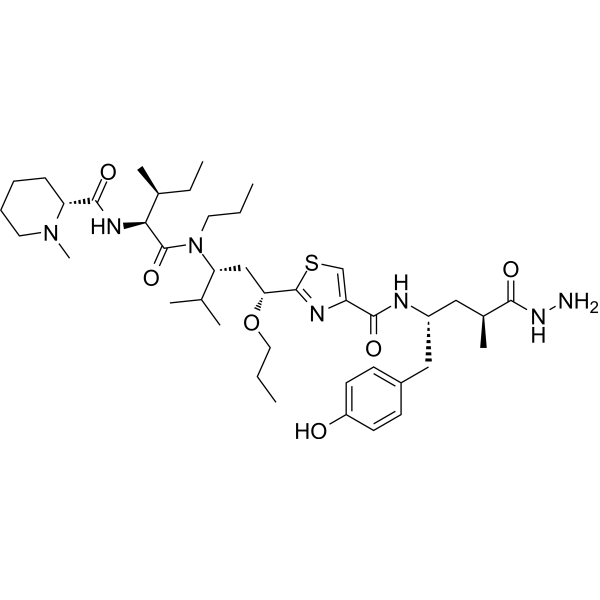
-
- HY-156249
-
|
|
ADC Cytotoxin
|
Cancer
|
|
NMS-P528 is a Duocarmycin derivative that can be used as an ADC payload. NMS-P528 can be used to synthesize NMS-P945 .
|
-
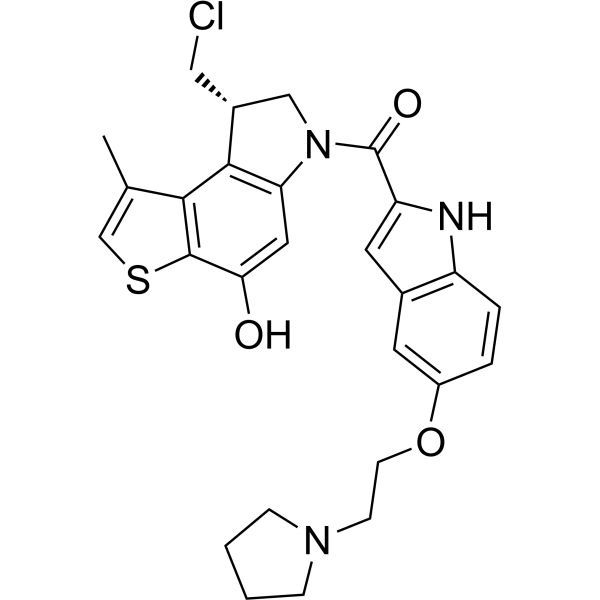
-
- HY-160597
-
|
|
ADC Cytotoxin
Topoisomerase
|
Cancer
|
|
Exatecan-amide-bicyclo[1.1.1]pentan-1-ol (Compound 79) is an exatecan (HY-13631) derivative that can be used as a payload in drug conjugates. Exatecan-amide-bicyclo[1.1.1]pentan-1-ol has significant inhibitory activity against a variety of tumor cell lines .
|
-
![Exatecan-amide-bicyclo[1.1.1]pentan-1-ol](//file.medchemexpress.com/product_pic/hy-160597.gif)
-
- HY-135901
-
|
|
ADC Cytotoxin
Bacterial
|
Cancer
|
|
Py-MPB-amino-C3-PBD is a cytotoxic agent comprised non-alkylating group. Py-MPB-amino-C3-PBD acts as the payload for ADCs. Antimicrobial activity .
|
-
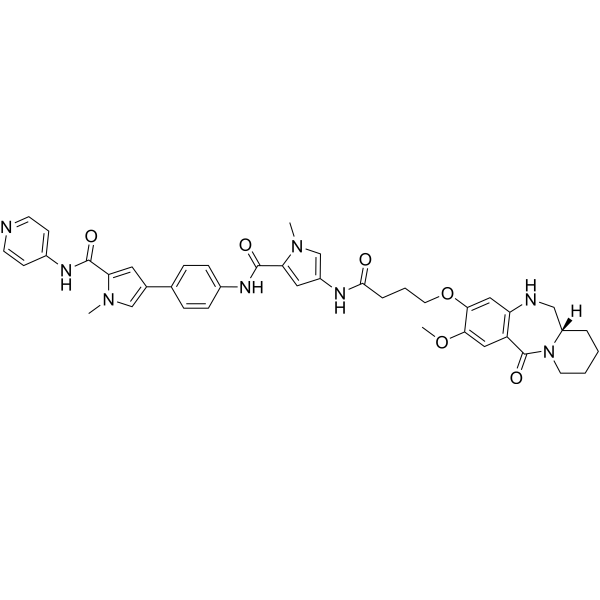
-
- HY-132158
-
|
|
Drug-Linker Conjugates for ADC
|
Cancer
|
|
MC-AAA-NHCH2OCH2COO-7-aminomethyl-10-methyl-11-fluoro camptothecin (compound 21a), a camptothecin payload, can be conjugated to a monoclonal antibody (mAb) for the synthesis of camptothecin antibody-drug conjugate (ADC) .
|
-
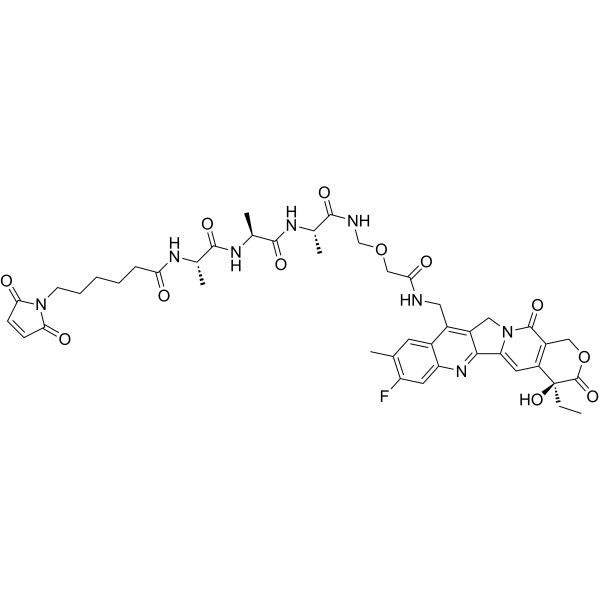
-
- HY-147193
-
|
|
NAMPT
|
Cancer
|
|
Nampt-IN-10 TFA (compound 4) is a Nicotinamide Phosphoribosyltransferase (NAMPT) inhibitor. Nampt-IN-10 TFA shows cellular potency to A2780 and CORL23 cells lines with IC50s of 5 and 19 nM, respectively. Nampt-IN-10 TFA can be used as a novel non-antimitotic payload for ADCs .
|
-
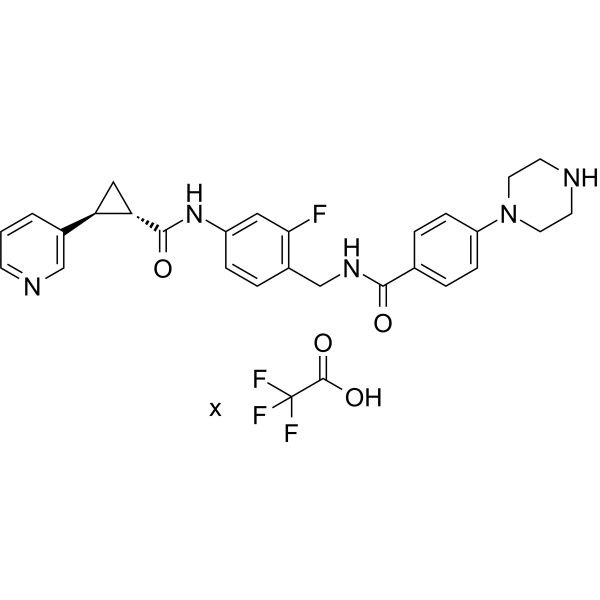
-
- HY-135900
-
|
|
ADC Cytotoxin
Bacterial
|
Cancer
|
|
Aniline-MPB-amino-C3-PBD is a cytotoxic agent comprised non-alkylating group. Aniline-MPB-amino-C3-PBD is a sequence-selective DNA minor-groove binding agent. Aniline-MPB-amino-C3-PBD acts as the payload for ADCs. Antimicrobial activity .
|
-
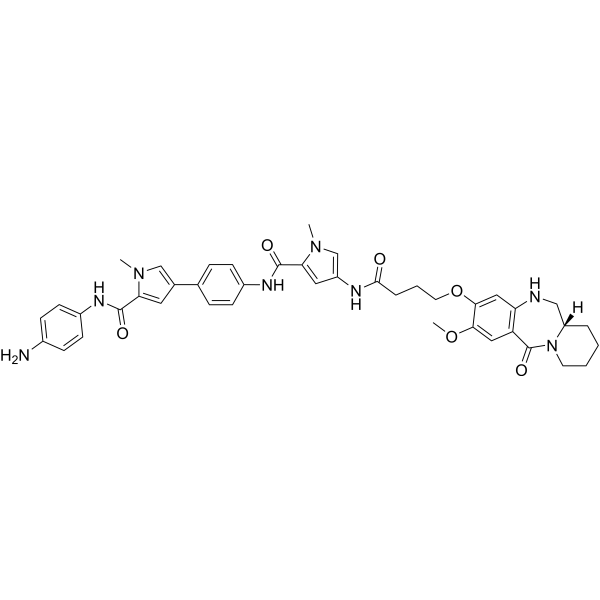
-
- HY-N12840
-
|
|
Others
|
Metabolic Disease
|
|
Logmalicid B is an iridoid glycoside compound that can be isolated from Cornus officinalis and can be used in diabetes research .
|
-

-
- HY-107502
-
|
|
Others
|
Cancer
|
|
Cryptophycin analog 1 is an ADC payload. Cryptophycin analog 1 shows anticancer activity. Cryptophycin analog 1 displays cell activity an order of magnitude more potent than approved ADC payloads MMAE and DM1 .
|
-
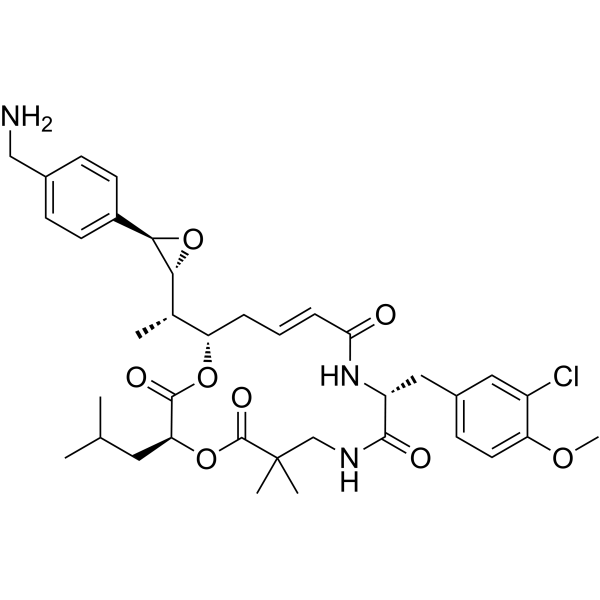
-
- HY-15581
-
|
Demethyldolastatin 10; Monomethylauristatin D; Monomethyl Dolastatin 10
|
Microtubule/Tubulin
ADC Cytotoxin
|
Cancer
|
|
MMAD is a potent tubulin inhibitor, is a toxin payload in antibody agent conjugates (ADCs).
|
-

-
- HY-156756
-
|
|
ADC Cytotoxin
|
Others
|
|
7-Hydroxymethyl-10,11-MDCPT is a payload that can be used for ADC synthesis .
|
-
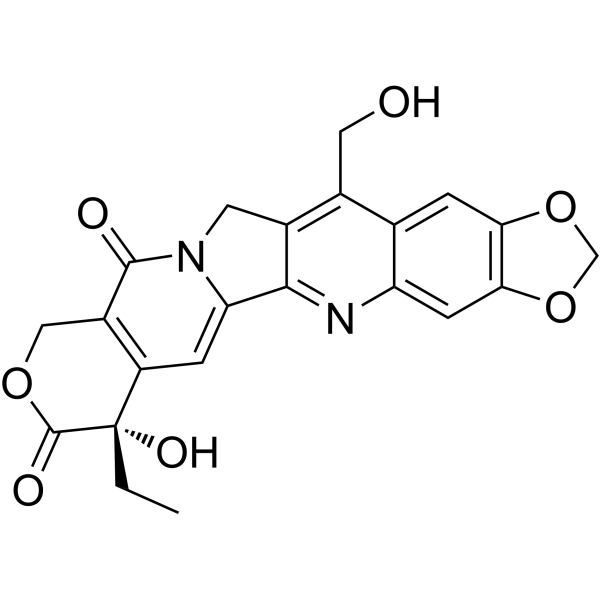
-
- HY-126663
-
|
|
ADC Cytotoxin
|
Cancer
|
|
N-Me-L-Ala-maytansinol is a hydrophobic, cell permeable payload used for making antibody-drug conjugate (ADC) .
|
-
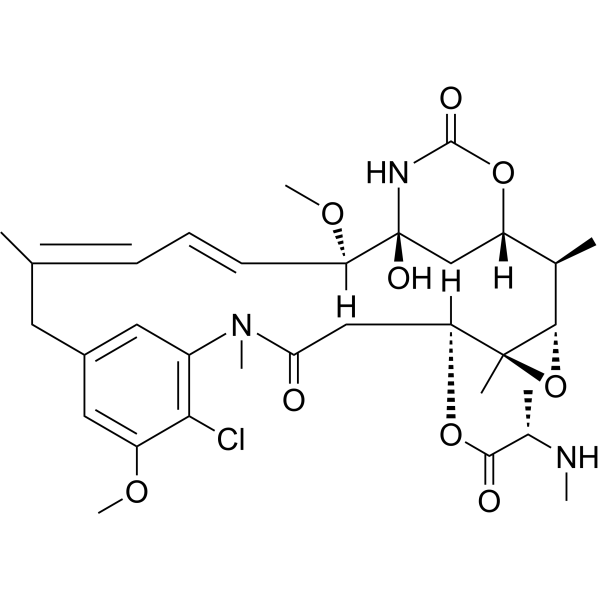
-
- HY-101127
-
|
PBD dimer
|
ADC Cytotoxin
|
Cancer
|
|
SGD-1882 is a cytotoxic, DNA minor-groove crosslinking agent pyrrolobenzodiazepine (PBD) dimer, acting as the payload for ADCs.
|
-

-
- HY-153639
-
-
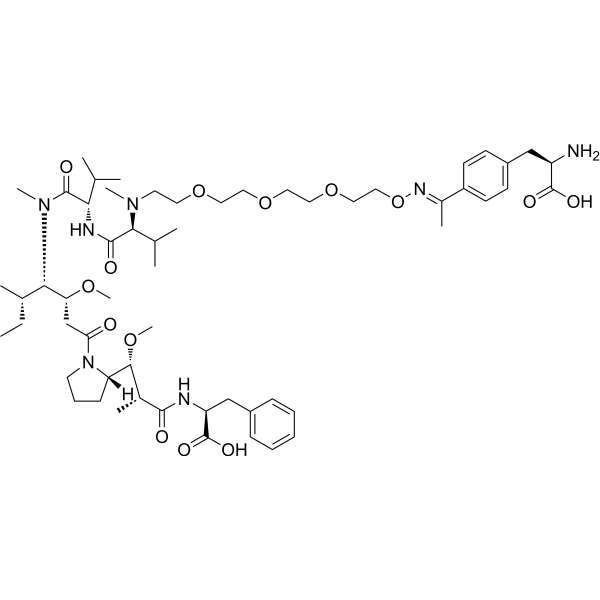
-
- HY-137774
-
-
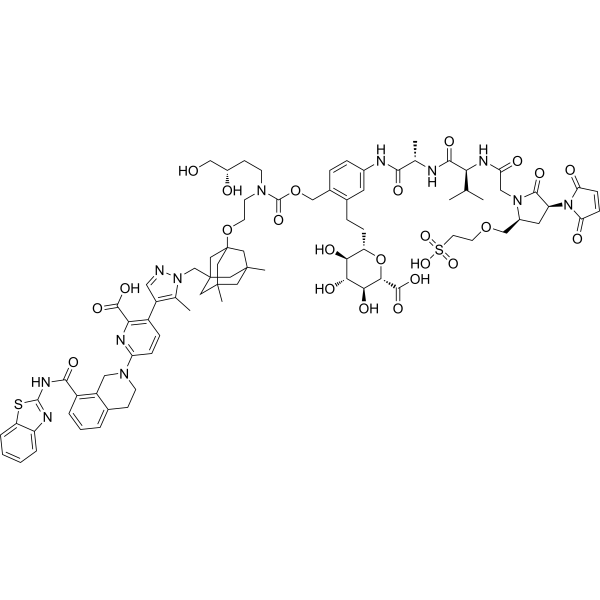
-
- HY-163099
-
|
|
Drug-Linker Conjugates for ADC
Topoisomerase
|
Cancer
|
|
P5(PEG24)-VC-PAB-exatecan is a camptothecin-based linker-payload platform based on the highly potent camptothecin derivative exatecan. P5(PEG24)-VC-PAB-exatecan has linker-payload structures. P5(PEG24)-VC-PAB-exatecan can be used for the research of tumor .
|
-

-
- HY-101141
-
|
|
Drug-Linker Conjugates for ADC
|
Cancer
|
|
sulfo-SPDB-DM4 is a agent-linker conjugate for ADC by using the maytansinebased payload (DM4, an antitubulin agent) via the sulfo-SPDB linker.
|
-
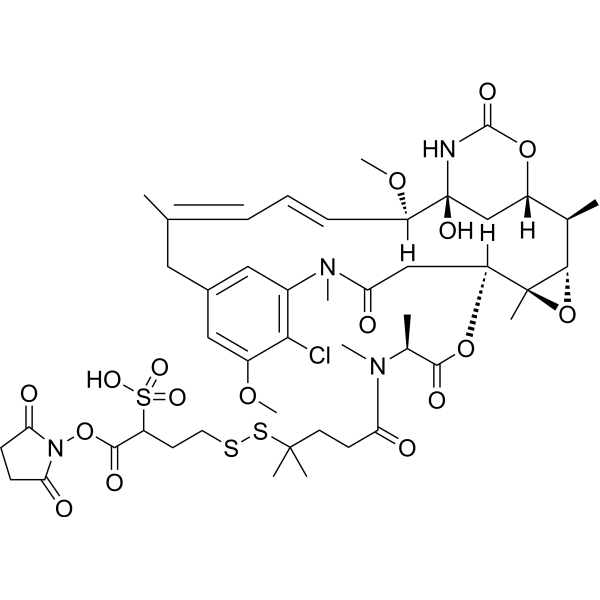
-
- HY-117371
-
|
(-)-Hemiasterlin; Milnamide B
|
ADC Cytotoxin
|
Cancer
|
|
Hemiasterlin ((-)-Hemiasterlin) is an antimitotic marine natural product with potent anticancer effcts. Hemiasterlin can be used as a cytotoxic payload (ADC Cytotoxin) in antibody-drug conjugates (ADCs) .
|
-
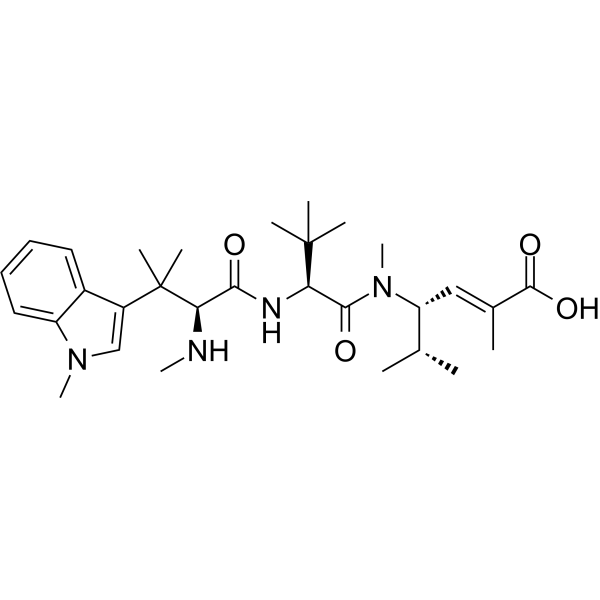
-
- HY-128952
-
|
SG3249
|
Drug-Linker Conjugates for ADC
DNA Alkylator/Crosslinker
|
Cancer
|
|
Tesirine (SG3249) is an antibody-drug conjugate (ADC) pyrrolobenzodiazepine (PBD) dimer payload. Tesirine combines potent antitumor activity with desirable physicochemical properties such as favorable hydrophobicity and improved conjugation characteristics. SG3199 (HY-101161) is the released warhead component of the ADC payload Tesirine. SG3199 retains picomolar activity in a panel of cancer cell lines. PBD dimers are highly efficient DNA minor groove cross-linking agents with potent cytotoxicity .
|
-
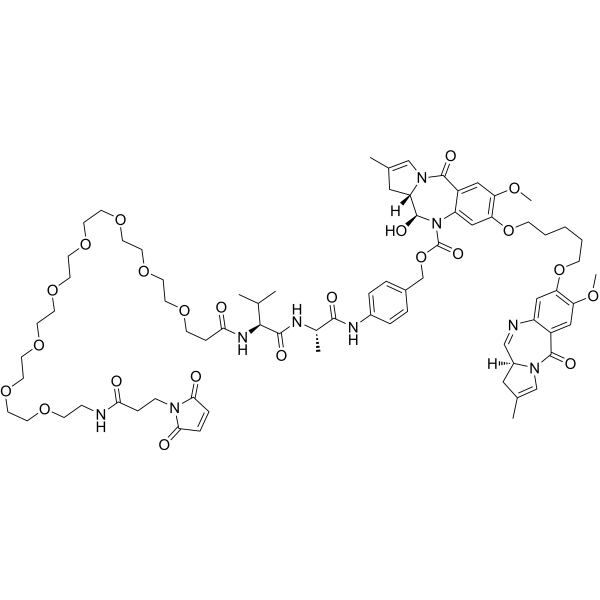
-
- HY-145663
-
|
|
Drug-Linker Conjugates for ADC
|
Cancer
|
|
HS-(CH2)3CO-L-Ala-D-Ala-L-Ala-NH-CH2-S-(CH2)5-CO-DM is a agent-linker (peptide-cleavable) conjugate for ADC. DM indicates the maytansinoid moiety .
|
-
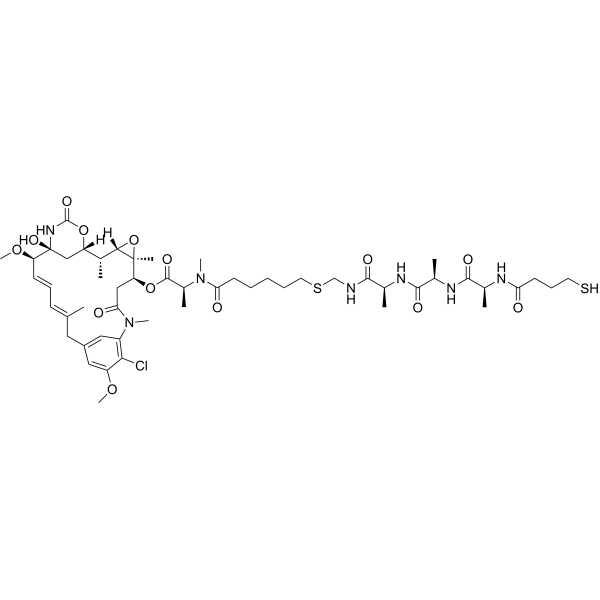
-
- HY-12460
-
|
|
Drug-Linker Conjugates for ADC
|
Cancer
|
|
SPDB-DM4 is a agent-linker conjugate for ADC by using the maytansinebased payload (DM4, a tubulin inhibitor) via a SPDB linker, exhibiting potent anti-tumor activity.
|
-
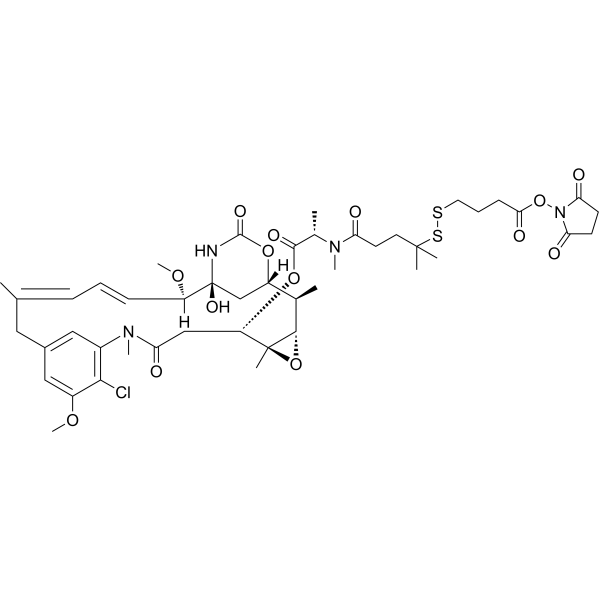
-
- HY-101161
-
SG3199
2 Publications Verification
|
DNA Alkylator/Crosslinker
ADC Cytotoxin
|
Cancer
|
|
SG3199 is a cytotoxic DNA minor groove interstrand crosslinking pyrrolobenzodiazepine (PBD) dimer. SG3199 is the released warhead component of the ADC payload Tesirine (SG3249) .
|
-
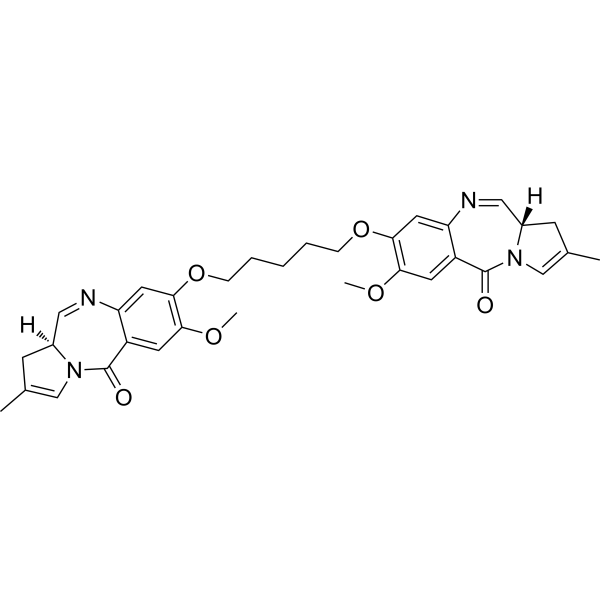
-
- HY-153909
-
|
|
Drug-Linker Conjugates for ADC
|
Cancer
|
|
SMP-33693 is a Drug-Linker Conjugate for ADC with a low payload shedding rate and has in vivo tumor inhibitory effects on ovarian cancer, gastric cancer, and breast cancer .
|
-

-
- HY-W440752
-
|
|
Liposome
|
Cancer
|
|
BP Lipid 113 is a liposome to simulate biological phospholipid membrane. Liposomes are the main component of vesicles with concentric phospholipid bilayer membranes, which can be used to construct drug delivery systems for anti-cancer and anti-infection fields. Highly polar water-soluble payloads can be trapped in the internal aqueous space of liposomes, while lipophilic payloads can partition into and become part of the lipid bilayer. Especially for delivering antisense oligonucleotides, it can overcome problems such as inefficient cellular uptake and rapid loss in the body .
|
-

-
- HY-W800749
-
|
|
Liposome
|
Cancer
|
|
BP Lipid 223 is a liposome to simulate biological phospholipid membrane. Liposomes are the main component of vesicles with concentric phospholipid bilayer membranes, which can be used to construct drug delivery systems for anti-cancer and anti-infection fields. Highly polar water-soluble payloads can be trapped in the internal aqueous space of liposomes, while lipophilic payloads can partition into and become part of the lipid bilayer. Especially for delivering antisense oligonucleotides, it can overcome problems such as inefficient cellular uptake and rapid loss in the body .
|
-

-
- HY-W800786
-
|
|
Liposome
|
Cancer
|
|
16:0 PE MCC is a liposome to simulate biological phospholipid membrane. Liposomes are the main component of vesicles with concentric phospholipid bilayer membranes, which can be used to construct drug delivery systems for anti-cancer and anti-infection fields. Highly polar water-soluble payloads can be trapped in the internal aqueous space of liposomes, while lipophilic payloads can partition into and become part of the lipid bilayer. Especially for delivering antisense oligonucleotides, it can overcome problems such as inefficient cellular uptake and rapid loss in the body .
|
-

-
- HY-W800787
-
|
|
Liposome
|
Cancer
|
|
18:1 PE MCC is a liposome to simulate biological phospholipid membrane. Liposomes are the main component of vesicles with concentric phospholipid bilayer membranes, which can be used to construct drug delivery systems for anti-cancer and anti-infection fields. Highly polar water-soluble payloads can be trapped in the internal aqueous space of liposomes, while lipophilic payloads can partition into and become part of the lipid bilayer. Especially for delivering antisense oligonucleotides, it can overcome problems such as inefficient cellular uptake and rapid loss in the body .
|
-

-
- HY-W440748
-
|
|
Liposome
|
Cancer
|
|
BP Lipid 109 is a liposome to simulate biological phospholipid membrane. Liposomes are the main component of vesicles with concentric phospholipid bilayer membranes, which can be used to construct drug delivery systems for anti-cancer and anti-infection fields. Highly polar water-soluble payloads can be trapped in the internal aqueous space of liposomes, while lipophilic payloads can partition into and become part of the lipid bilayer. Especially for delivering antisense oligonucleotides, it can overcome problems such as inefficient cellular uptake and rapid loss in the body .
|
-

-
- HY-W800737
-
|
|
Liposome
|
Cancer
|
|
BP Lipid 126 is a liposome to simulate biological phospholipid membrane. Liposomes are the main component of vesicles with concentric phospholipid bilayer membranes, which can be used to construct drug delivery systems for anti-cancer and anti-infection fields. Highly polar water-soluble payloads can be trapped in the internal aqueous space of liposomes, while lipophilic payloads can partition into and become part of the lipid bilayer. Especially for delivering antisense oligonucleotides, it can overcome problems such as inefficient cellular uptake and rapid loss in the body .
|
-

-
- HY-W440698
-
|
|
Liposome
|
Cancer
|
|
Cholesterol-PEG-Acid (MW 2000) is a liposome to simulate biological phospholipid membrane. Liposomes are the main component of vesicles with concentric phospholipid bilayer membranes, which can be used to construct drug delivery systems for anti-cancer and anti-infection fields. Highly polar water-soluble payloads can be trapped in the internal aqueous space of liposomes, while lipophilic payloads can partition into and become part of the lipid bilayer. Especially for delivering antisense oligonucleotides, it can overcome problems such as inefficient cellular uptake and rapid loss in the body .
|
-

-
- HY-W440743
-
|
|
Liposome
|
Cancer
|
|
BP Lipid 103 is a liposome to simulate biological phospholipid membrane. Liposomes are the main component of vesicles with concentric phospholipid bilayer membranes, which can be used to construct drug delivery systems for anti-cancer and anti-infection fields. Highly polar water-soluble payloads can be trapped in the internal aqueous space of liposomes, while lipophilic payloads can partition into and become part of the lipid bilayer. Especially for delivering antisense oligonucleotides, it can overcome problems such as inefficient cellular uptake and rapid loss in the body .
|
-

-
- HY-W440751
-
|
|
Liposome
|
Cancer
|
|
BP Lipid 112 is a liposome to simulate biological phospholipid membrane. Liposomes are the main component of vesicles with concentric phospholipid bilayer membranes, which can be used to construct drug delivery systems for anti-cancer and anti-infection fields. Highly polar water-soluble payloads can be trapped in the internal aqueous space of liposomes, while lipophilic payloads can partition into and become part of the lipid bilayer. Especially for delivering antisense oligonucleotides, it can overcome problems such as inefficient cellular uptake and rapid loss in the body .
|
-

-
- HY-W440981
-
|
|
Liposome
|
Cancer
|
|
SPPC is a liposome to simulate biological phospholipid membrane. Liposomes are the main component of vesicles with concentric phospholipid bilayer membranes, which can be used to construct drug delivery systems for anti-cancer and anti-infection fields. Highly polar water-soluble payloads can be trapped in the internal aqueous space of liposomes, while lipophilic payloads can partition into and become part of the lipid bilayer. Especially for delivering antisense oligonucleotides, it can overcome problems such as inefficient cellular uptake and rapid loss in the body .
|
-

-
- HY-W440803
-
|
|
Liposome
|
Cancer
|
|
BP Lipid 218 is a liposome to simulate biological phospholipid membrane. Liposomes are the main component of vesicles with concentric phospholipid bilayer membranes, which can be used to construct drug delivery systems for anti-cancer and anti-infection fields. Highly polar water-soluble payloads can be trapped in the internal aqueous space of liposomes, while lipophilic payloads can partition into and become part of the lipid bilayer. Especially for delivering antisense oligonucleotides, it can overcome problems such as inefficient cellular uptake and rapid loss in the body .
|
-

-
- HY-W440800
-
|
|
Liposome
|
Cancer
|
|
BP Lipid 226 is a liposome to simulate biological phospholipid membrane. Liposomes are the main component of vesicles with concentric phospholipid bilayer membranes, which can be used to construct drug delivery systems for anti-cancer and anti-infection fields. Highly polar water-soluble payloads can be trapped in the internal aqueous space of liposomes, while lipophilic payloads can partition into and become part of the lipid bilayer. Especially for delivering antisense oligonucleotides, it can overcome problems such as inefficient cellular uptake and rapid loss in the body .
|
-

-
- HY-W440766
-
|
|
Liposome
|
Cancer
|
|
BP Lipid 209 is a liposome to simulate biological phospholipid membrane. Liposomes are the main component of vesicles with concentric phospholipid bilayer membranes, which can be used to construct drug delivery systems for anti-cancer and anti-infection fields. Highly polar water-soluble payloads can be trapped in the internal aqueous space of liposomes, while lipophilic payloads can partition into and become part of the lipid bilayer. Especially for delivering antisense oligonucleotides, it can overcome problems such as inefficient cellular uptake and rapid loss in the body .
|
-

-
- HY-W440957
-
|
|
Liposome
|
Cancer
|
|
PMPC is a liposome to simulate biological phospholipid membrane. Liposomes are the main component of vesicles with concentric phospholipid bilayer membranes, which can be used to construct drug delivery systems for anti-cancer and anti-infection fields. Highly polar water-soluble payloads can be trapped in the internal aqueous space of liposomes, while lipophilic payloads can partition into and become part of the lipid bilayer. Especially for delivering antisense oligonucleotides, it can overcome problems such as inefficient cellular uptake and rapid loss in the body .
|
-

-
- HY-P2073
-
|
|
Liposome
|
Cancer
|
|
Cyclo(δ-Ala-L-Val) is a liposome to simulate biological phospholipid membrane. Liposomes are the main component of vesicles with concentric phospholipid bilayer membranes, which can be used to construct drug delivery systems for anti-cancer and anti-infection fields. Highly polar water-soluble payloads can be trapped in the internal aqueous space of liposomes, while lipophilic payloads can partition into and become part of the lipid bilayer. Especially for delivering antisense oligonucleotides, it can overcome problems such as inefficient cellular uptake and rapid loss in the body .
|
-

-
- HY-P10442
-
|
|
Liposome
|
Cancer
|
|
Cinnamosyn is a liposome to simulate biological phospholipid membrane. Liposomes are the main component of vesicles with concentric phospholipid bilayer membranes, which can be used to construct drug delivery systems for anti-cancer and anti-infection fields. Highly polar water-soluble payloads can be trapped in the internal aqueous space of liposomes, while lipophilic payloads can partition into and become part of the lipid bilayer. Especially for delivering antisense oligonucleotides, it can overcome problems such as inefficient cellular uptake and rapid loss in the body .
|
-

-
- HY-153908
-
|
|
Drug-Linker Conjugates for ADC
|
Cancer
|
|
SMP-93566 is a kind of antibody-drug conjugates (ADCs) with a low payload shedding rate and has in vivo tumor inhibitory effects on ovarian cancer, gastric cancer, and breast cancer .
|
-
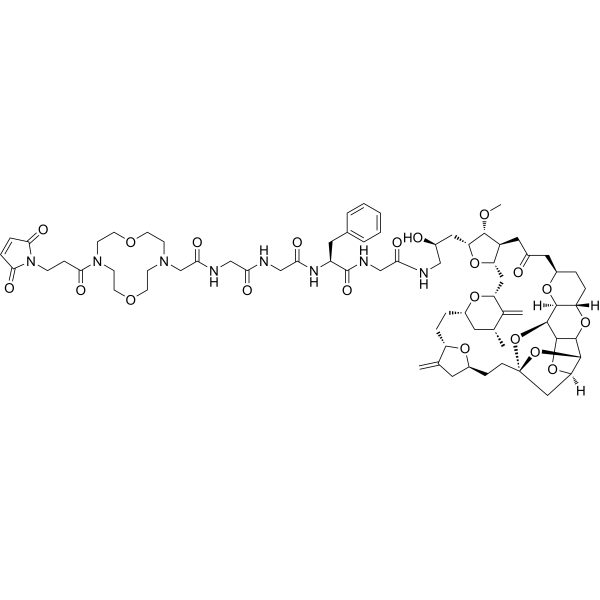
-
- HY-145078
-
|
|
Drug-Linker Conjugates for ADC
|
Cancer
|
|
PNU-EDA-Gly5 is an oligo-glycine linker-payload for ADC synthesis, composed of a DNA topoisomerase I inhibitor PNU-159682 and a linker EDA-Gly5 .
|
-
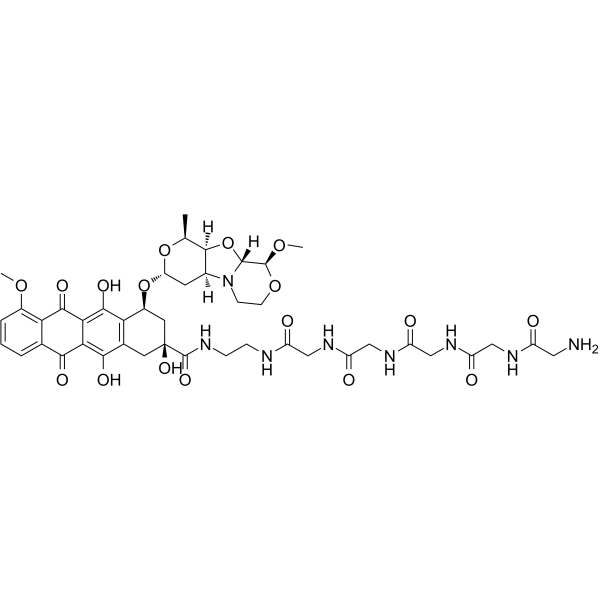
-
- HY-W440711
-
|
|
Liposome
|
Cancer
|
|
Cholesterol-PEG-Biotin (MW 2000) is a liposome to simulate biological phospholipid membrane. Liposomes are the main component of vesicles with concentric phospholipid bilayer membranes, which can be used to construct drug delivery systems for anti-cancer and anti-infection fields. Highly polar water-soluble payloads can be trapped in the internal aqueous space of liposomes, while lipophilic payloads can partition into and become part of the lipid bilayer. Especially for delivering antisense oligonucleotides, it can overcome problems such as inefficient cellular uptake and rapid loss in the body .
|
-

-
- HY-W800777
-
|
|
Liposome
|
Cancer
|
|
6-(3-Hydroxypropylamino)hexyl 2-hexyldecanoate is a liposome to simulate biological phospholipid membrane. Liposomes are the main component of vesicles with concentric phospholipid bilayer membranes, which can be used to construct drug delivery systems for anti-cancer and anti-infection fields. Highly polar water-soluble payloads can be trapped in the internal aqueous space of liposomes, while lipophilic payloads can partition into and become part of the lipid bilayer. Especially for delivering antisense oligonucleotides, it can overcome problems such as inefficient cellular uptake and rapid loss in the body .
|
-

-
- HY-W800785
-
|
|
Liposome
|
Cancer
|
|
16:0-23:2 Diyne PC is a liposome to simulate biological phospholipid membrane. Liposomes are the main component of vesicles with concentric phospholipid bilayer membranes, which can be used to construct drug delivery systems for anti-cancer and anti-infection fields. Highly polar water-soluble payloads can be trapped in the internal aqueous space of liposomes, while lipophilic payloads can partition into and become part of the lipid bilayer. Especially for delivering antisense oligonucleotides, it can overcome problems such as inefficient cellular uptake and rapid loss in the body .
|
-

-
- HY-W440706
-
|
|
Liposome
|
Cancer
|
|
Cholesterol-PEG-alcohol (MW 2000) is a liposome to simulate biological phospholipid membrane. Liposomes are the main component of vesicles with concentric phospholipid bilayer membranes, which can be used to construct drug delivery systems for anti-cancer and anti-infection fields. Highly polar water-soluble payloads can be trapped in the internal aqueous space of liposomes, while lipophilic payloads can partition into and become part of the lipid bilayer. Especially for delivering antisense oligonucleotides, it can overcome problems such as inefficient cellular uptake and rapid loss in the body .
|
-

-
- HY-W440719
-
|
|
Liposome
|
Cancer
|
|
Cholesterol-PEG-MAL (MW 2000) is a liposome to simulate biological phospholipid membrane. Liposomes are the main component of vesicles with concentric phospholipid bilayer membranes, which can be used to construct drug delivery systems for anti-cancer and anti-infection fields. Highly polar water-soluble payloads can be trapped in the internal aqueous space of liposomes, while lipophilic payloads can partition into and become part of the lipid bilayer. Especially for delivering antisense oligonucleotides, it can overcome problems such as inefficient cellular uptake and rapid loss in the body .
|
-

-
- HY-W440694
-
|
|
Liposome
|
Cancer
|
|
Cholesterol-PEG-Azide (MW 2000) is a liposome to simulate biological phospholipid membrane. Liposomes are the main component of vesicles with concentric phospholipid bilayer membranes, which can be used to construct drug delivery systems for anti-cancer and anti-infection fields. Highly polar water-soluble payloads can be trapped in the internal aqueous space of liposomes, while lipophilic payloads can partition into and become part of the lipid bilayer. Especially for delivering antisense oligonucleotides, it can overcome problems such as inefficient cellular uptake and rapid loss in the body .
|
-

-
- HY-W440690
-
|
|
Liposome
|
Cancer
|
|
Cholesterol-PEG-Amine (MW 2000) is a liposome to simulate biological phospholipid membrane. Liposomes are the main component of vesicles with concentric phospholipid bilayer membranes, which can be used to construct drug delivery systems for anti-cancer and anti-infection fields. Highly polar water-soluble payloads can be trapped in the internal aqueous space of liposomes, while lipophilic payloads can partition into and become part of the lipid bilayer. Especially for delivering antisense oligonucleotides, it can overcome problems such as inefficient cellular uptake and rapid loss in the body .
|
-

-
- HY-138913
-
|
|
Liposome
|
Cancer
|
|
2H-Cho-Arg (TFA) is a liposome to simulate biological phospholipid membrane. Liposomes are the main component of vesicles with concentric phospholipid bilayer membranes, which can be used to construct drug delivery systems for anti-cancer and anti-infection fields. Highly polar water-soluble payloads can be trapped in the internal aqueous space of liposomes, while lipophilic payloads can partition into and become part of the lipid bilayer. Especially for delivering antisense oligonucleotides, it can overcome problems such as inefficient cellular uptake and rapid loss in the body .
|
-

-
- HY-W340832
-
|
|
Liposome
|
Cancer
|
|
18:1 Biotinyl Cap PE is a liposome to simulate biological phospholipid membrane. Liposomes are the main component of vesicles with concentric phospholipid bilayer membranes, which can be used to construct drug delivery systems for anti-cancer and anti-infection fields. Highly polar water-soluble payloads can be trapped in the internal aqueous space of liposomes, while lipophilic payloads can partition into and become part of the lipid bilayer. Especially for delivering antisense oligonucleotides, it can overcome problems such as inefficient cellular uptake and rapid loss in the body .
|
-

- HY-W800778
-
|
|
Liposome
|
Cancer
|
|
Bis(2-butyloctyl) 10-oxononadecanedioate is a liposome to simulate biological phospholipid membrane. Liposomes are the main component of vesicles with concentric phospholipid bilayer membranes, which can be used to construct drug delivery systems for anti-cancer and anti-infection fields. Highly polar water-soluble payloads can be trapped in the internal aqueous space of liposomes, while lipophilic payloads can partition into and become part of the lipid bilayer. Especially for delivering antisense oligonucleotides, it can overcome problems such as inefficient cellular uptake and rapid loss in the body .
|
-

- HY-W591913
-
|
|
Liposome
|
Cancer
|
|
Cholesterol-PEG-methoxy, MW 2000 is a liposome to simulate biological phospholipid membrane. Liposomes are the main component of vesicles with concentric phospholipid bilayer membranes, which can be used to construct drug delivery systems for anti-cancer and anti-infection fields. Highly polar water-soluble payloads can be trapped in the internal aqueous space of liposomes, while lipophilic payloads can partition into and become part of the lipid bilayer. Especially for delivering antisense oligonucleotides, it can overcome problems such as inefficient cellular uptake and rapid loss in the body .
|
-

- HY-153725
-
|
|
Liposome
|
Cancer
|
|
17:1 Lyso PC is a liposome to simulate biological phospholipid membrane. Liposomes are the main component of vesicles with concentric phospholipid bilayer membranes, which can be used to construct drug delivery systems for anti-cancer and anti-infection fields. Highly polar water-soluble payloads can be trapped in the internal aqueous space of liposomes, while lipophilic payloads can partition into and become part of the lipid bilayer. Especially for delivering antisense oligonucleotides, it can overcome problems such as inefficient cellular uptake and rapid loss in the body .
|
-

- HY-W440727
-
|
|
Liposome
|
Cancer
|
|
Cholesterol-PEG-Vinylsulfone (MW 2000) is a liposome to simulate biological phospholipid membrane. Liposomes are the main component of vesicles with concentric phospholipid bilayer membranes, which can be used to construct drug delivery systems for anti-cancer and anti-infection fields. Highly polar water-soluble payloads can be trapped in the internal aqueous space of liposomes, while lipophilic payloads can partition into and become part of the lipid bilayer. Especially for delivering antisense oligonucleotides, it can overcome problems such as inefficient cellular uptake and rapid loss in the body .
|
-

- HY-W440724
-
|
|
Liposome
|
Cancer
|
|
Cholesterol-PEG-Thiol (MW 3400) is a liposome to simulate biological phospholipid membrane. Liposomes are the main component of vesicles with concentric phospholipid bilayer membranes, which can be used to construct drug delivery systems for anti-cancer and anti-infection fields. Highly polar water-soluble payloads can be trapped in the internal aqueous space of liposomes, while lipophilic payloads can partition into and become part of the lipid bilayer. Especially for delivering antisense oligonucleotides, it can overcome problems such as inefficient cellular uptake and rapid loss in the body .
|
-

- HY-W440820
-
|
|
Liposome
|
Cancer
|
|
Bis(bis(2-carboxyethyl)aminopropyl)methylamine is a liposome to simulate biological phospholipid membrane. Liposomes are the main component of vesicles with concentric phospholipid bilayer membranes, which can be used to construct drug delivery systems for anti-cancer and anti-infection fields. Highly polar water-soluble payloads can be trapped in the internal aqueous space of liposomes, while lipophilic payloads can partition into and become part of the lipid bilayer. Especially for delivering antisense oligonucleotides, it can overcome problems such as inefficient cellular uptake and rapid loss in the body .
|
-

- HY-W440931
-
|
|
Liposome
|
Cancer
|
|
MPEG2000-DMG is a liposome to simulate biological phospholipid membrane. Liposomes are the main component of vesicles with concentric phospholipid bilayer membranes, which can be used to construct drug delivery systems for anti-cancer and anti-infection fields. Highly polar water-soluble payloads can be trapped in the internal aqueous space of liposomes, while lipophilic payloads can partition into and become part of the lipid bilayer. Especially for delivering antisense oligonucleotides, it can overcome problems such as inefficient cellular uptake and rapid loss in the body .
|
-

- HY-148127
-
|
|
Drug-Linker Conjugates for ADC
|
Cancer
|
|
TAM558 is a payload molecule used for the synthesis of OMTX705. OMTX705 is a humanized anti-fibroblast-activating protein (FAP) antibody conjugated to the cytolysin TAM470 (HY-148128), with antitumor activity .
|
-
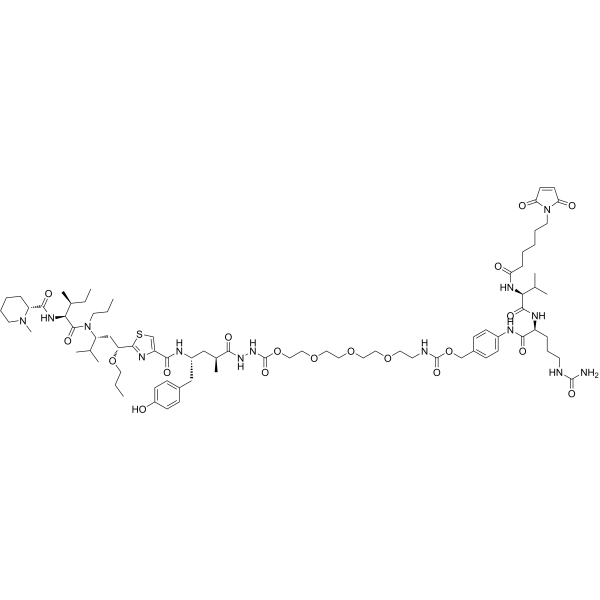
- HY-157078
-
|
|
ADC Cytotoxin
|
Cancer
|
|
Eg5-IN-2 (Compound Scaffold B (4)) is an Eg5 inhibitor (IC50: < 0.5 nM). Eg5-IN-2 can be used as an ADC payload for synthesis of ADCs .
|
-
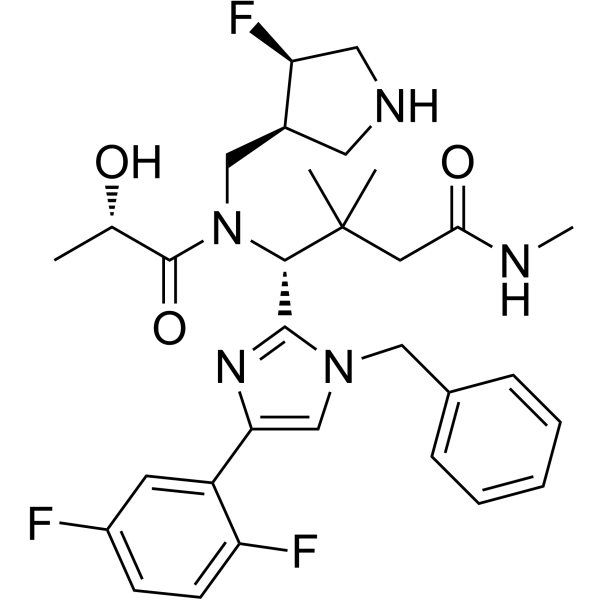
- HY-147363
-
|
|
Drug-Linker Conjugates for ADC
|
Others
|
|
DIBAC-GGFG-NH2CH2-Dxd (compound LP4), a Camptothecin (HY-16560) derivative, is a linker-payload of protein-agent conjugates . Dxd (HY-13631D) can be used as a payload for the antibody-coupling drug ADC (DS-8201a).DIBAC-GGFG-NH2CH2-Dxd is a click chemistry reagent, it contains a DBCO group that can undergo strain-promoted alkyne-azide cycloaddition (SPAAC) with molecules containing Azide groups.
|
-
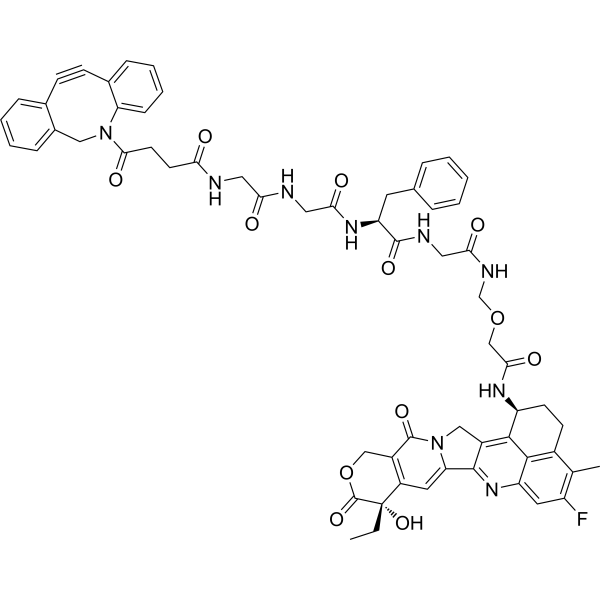
- HY-W140488
-
|
|
Liposome
|
Cancer
|
|
1,2-Didecanoyl-sn-glycero-3-phosphoethanolamine is a liposome to simulate biological phospholipid membrane. Liposomes are the main component of vesicles with concentric phospholipid bilayer membranes, which can be used to construct drug delivery systems for anti-cancer and anti-infection fields. Highly polar water-soluble payloads can be trapped in the internal aqueous space of liposomes, while lipophilic payloads can partition into and become part of the lipid bilayer. Especially for delivering antisense oligonucleotides, it can overcome problems such as inefficient cellular uptake and rapid loss in the body .
|
-

- HY-W800784
-
|
|
Liposome
|
Cancer
|
|
23:2 Diyne PE [DC(8,9)PE] is a liposome to simulate biological phospholipid membrane. Liposomes are the main component of vesicles with concentric phospholipid bilayer membranes, which can be used to construct drug delivery systems for anti-cancer and anti-infection fields. Highly polar water-soluble payloads can be trapped in the internal aqueous space of liposomes, while lipophilic payloads can partition into and become part of the lipid bilayer. Especially for delivering antisense oligonucleotides, it can overcome problems such as inefficient cellular uptake and rapid loss in the body .
|
-
![23:2 Diyne PE [DC(8,9)PE]](//file.medchemexpress.com/product_pic/hy-w800784.gif)
- HY-134174
-
|
|
Liposome
|
Cancer
|
|
1-Palmitoyl-2-oleoyl-sn-glycero-3-phosphate is a liposome to simulate biological phospholipid membrane. Liposomes are the main component of vesicles with concentric phospholipid bilayer membranes, which can be used to construct drug delivery systems for anti-cancer and anti-infection fields. Highly polar water-soluble payloads can be trapped in the internal aqueous space of liposomes, while lipophilic payloads can partition into and become part of the lipid bilayer. Especially for delivering antisense oligonucleotides, it can overcome problems such as inefficient cellular uptake and rapid loss in the body .
|
-

- HY-156756S
-
-
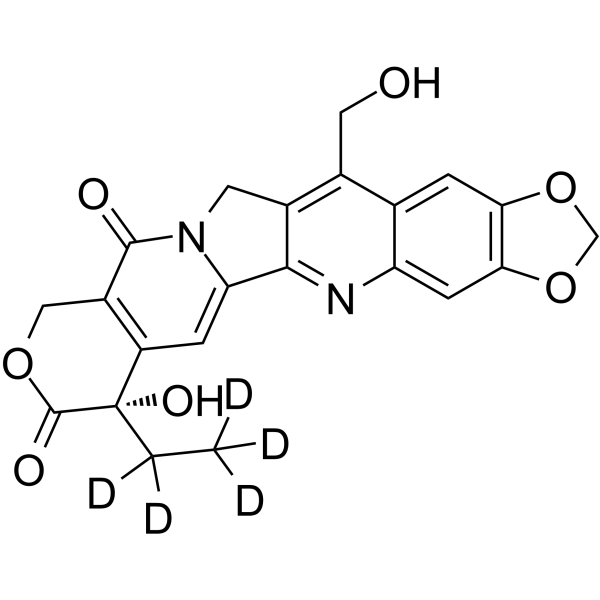
- HY-136297
-
|
|
Drug-Linker Conjugates for ADC
|
Cancer
|
|
DGN549-C consists a cleavable ADC linker valine-alanine (va) and PBD dimer. DGN549 is a novel DNA-alkylating cytotoxic payload and can be used in the synthesis of antibody-agent conjugates (ADCs) .
|
-
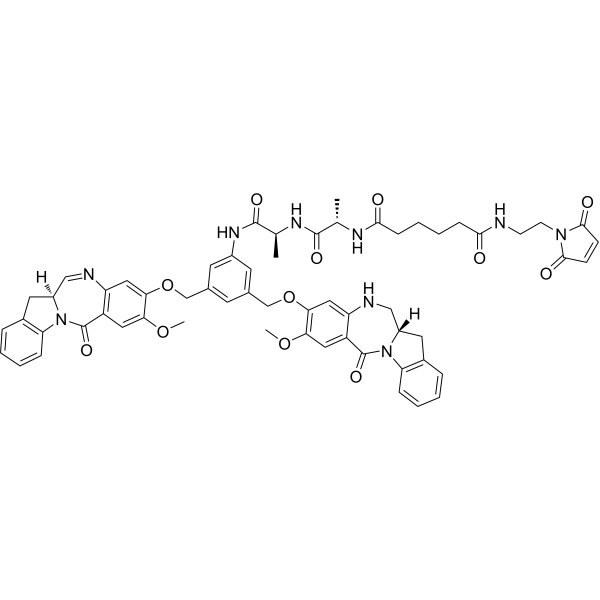
- HY-W800734
-
|
MPPC
|
Liposome
|
Cancer
|
|
1-Myristoyl-2-palmitoyl-sn-glycero-3-phosphocholine (MPPC) is a liposome to simulate biological phospholipid membrane. Liposomes are the main component of vesicles with concentric phospholipid bilayer membranes, which can be used to construct drug delivery systems for anti-cancer and anti-infection fields. Highly polar water-soluble payloads can be trapped in the internal aqueous space of liposomes, while lipophilic payloads can partition into and become part of the lipid bilayer. Especially for delivering antisense oligonucleotides, it can overcome problems such as inefficient cellular uptake and rapid loss in the body .
|
-

- HY-115435
-
|
DMPS-Na; Dimyristoyl phosphatidylserine sodium
|
Liposome
|
Cancer
|
|
1,2-Dimyristoyl-sn-glycero-3-phospho-L-serine sodium (DMPS-Na; Dimyristoyl phosphatidylserine sodium) is a liposome to simulate biological phospholipid membrane. Liposomes are the main component of vesicles with concentric phospholipid bilayer membranes, which can be used to construct drug delivery systems for anti-cancer and anti-infection fields. Highly polar water-soluble payloads can be trapped in the internal aqueous space of liposomes, while lipophilic payloads can partition into and become part of the lipid bilayer. Especially for delivering antisense oligonucleotides, it can overcome problems such as inefficient cellular uptake and rapid loss in the body .
|
-

- HY-W440958
-
|
|
Liposome
|
Cancer
|
|
1-Palmitoyl-2-stearoyl-sn-glycero-3-phosphocholine is a liposome to simulate biological phospholipid membrane. Liposomes are the main component of vesicles with concentric phospholipid bilayer membranes, which can be used to construct drug delivery systems for anti-cancer and anti-infection fields. Highly polar water-soluble payloads can be trapped in the internal aqueous space of liposomes, while lipophilic payloads can partition into and become part of the lipid bilayer. Especially for delivering antisense oligonucleotides, it can overcome problems such as inefficient cellular uptake and rapid loss in the body .
|
-

- HY-154915
-
-

- HY-W339838
-
|
14:0 Lyso PG
|
Liposome
|
Cancer
|
|
1-Myristoyl-2-hydroxy-sn-glycero-3-PG sodium (14:0 Lyso PG) is a liposome to simulate biological phospholipid membrane. Liposomes are the main component of vesicles with concentric phospholipid bilayer membranes, which can be used to construct drug delivery systems for anti-cancer and anti-infection fields. Highly polar water-soluble payloads can be trapped in the internal aqueous space of liposomes, while lipophilic payloads can partition into and become part of the lipid bilayer. Especially for delivering antisense oligonucleotides, it can overcome problems such as inefficient cellular uptake and rapid loss in the body .
|
-

- HY-141615
-
|
PDME; 16:0 Dimethyl PE
|
Liposome
|
Cancer
|
|
1,2-Dipalmitoyl-sn-glycero-3-phospho-N,N-dimethylethanolamine (PDME; 16:0 Dimethyl PE) is a liposome to simulate biological phospholipid membrane. Liposomes are the main component of vesicles with concentric phospholipid bilayer membranes, which can be used to construct drug delivery systems for anti-cancer and anti-infection fields. Highly polar water-soluble payloads can be trapped in the internal aqueous space of liposomes, while lipophilic payloads can partition into and become part of the lipid bilayer. Especially for delivering antisense oligonucleotides, it can overcome problems such as inefficient cellular uptake and rapid loss in the body .
|
-

- HY-126686
-
|
|
Drug-Linker Conjugates for ADC
|
Cancer
|
|
Mal-Phe-C4-VC-PAB-MMAE is made by MMAE conjugated to Mal-Phe-C4-VC-PAB linker. Monomethyl auristatin E (MMAE), a potent tubulin inhibitor, is a toxin payload in antibody agent conjugate.
|
-
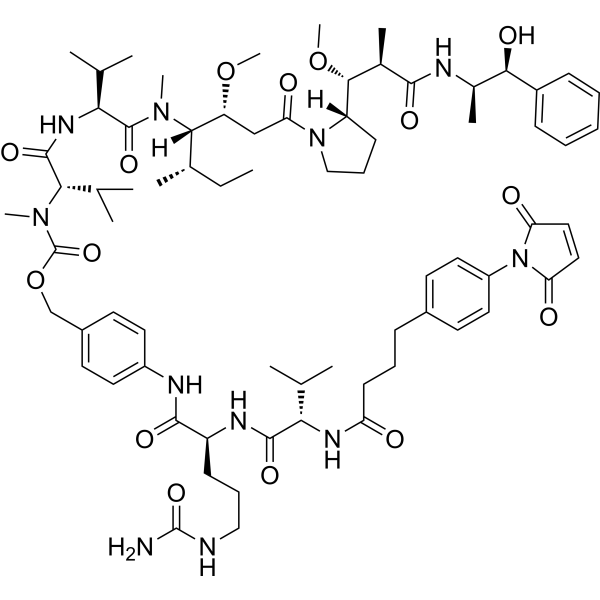
- HY-160910
-
|
|
STING
ADC Cytotoxin
|
Cancer
|
|
STING agonist-35 (Compoind 1a) is an agonist for stimulator of interferon genes (STING), which activates the wild type STING and mutated type STING (R232H), with a rate of 99% and 92%. STING agonist-35 is a potent payload for ADC .
|
-

- HY-W343736
-
|
1,3-DPPE; 1,3-Dipalmitoyl-sn-glycero-2-PE
|
Liposome
|
Cancer
|
|
1,3-Dipalmitoyl-glycero-2-phosphoethanolamine (1,3-DPPE; 1,3-Dipalmitoyl-sn-glycero-2-PE) is a liposome to simulate biological phospholipid membrane. Liposomes are the main component of vesicles with concentric phospholipid bilayer membranes, which can be used to construct drug delivery systems for anti-cancer and anti-infection fields. Highly polar water-soluble payloads can be trapped in the internal aqueous space of liposomes, while lipophilic payloads can partition into and become part of the lipid bilayer. Especially for delivering antisense oligonucleotides, it can overcome problems such as inefficient cellular uptake and rapid loss in the body .
|
-

- HY-147193A
-
|
|
NAMPT
|
Cancer
|
|
Nampt-IN-10 trihydrochloride (compound 4) is a Nicotinamide Phosphoribosyltransferase (NAMPT) inhibitor. Nampt-IN-10 trihydrochloride shows cellular potency to A2780 and CORL23 cell lines with IC50 values of 5 and 19 nM, respectively. Nampt-IN-10 trihydrochloride can be used as a novel non-antimitotic payload for antibody-drug conjugate (ADC) .
|
-
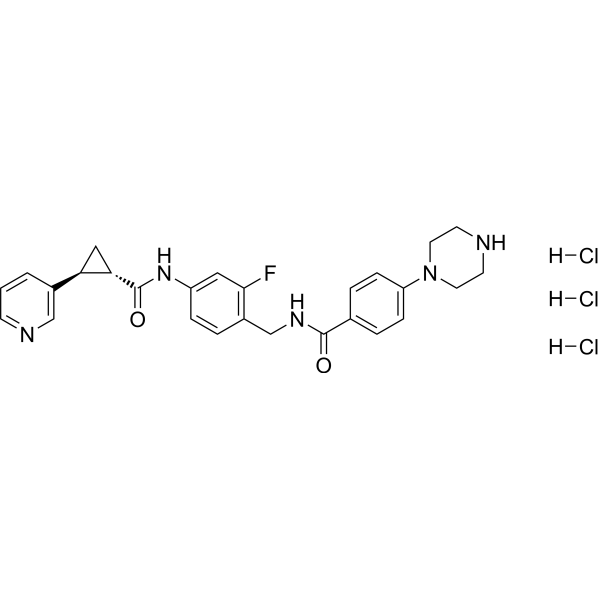
- HY-P99813
-
|
HER3-DXd
|
Antibody-Drug Conjugates (ADCs)
|
Cancer
|
|
Patritumab deruxtecan (HER3-DXd) is an antibody-drug conjugate (ADC) consisting of a fully human anti-HER3 IgG1 monoclonal antibody Patritumab (HY-P99275) attached to a topoisomerase I inhibitor payload via a tetrapeptide-based cleavable linker. Patritumab deruxtecan shows anticancer activity .
|
-
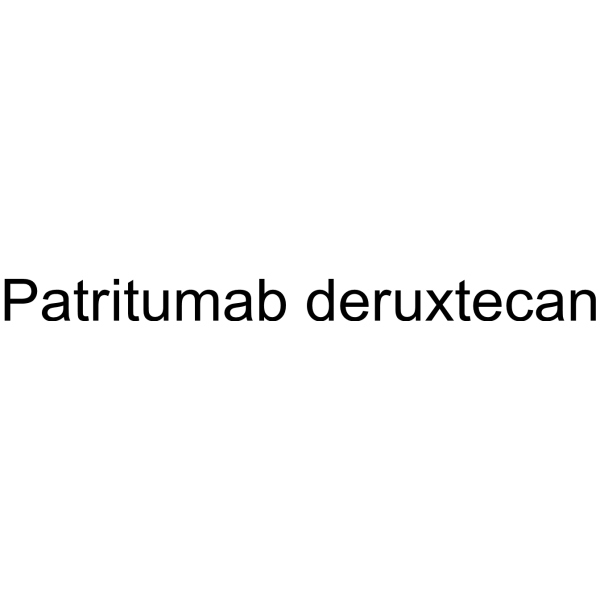
- HY-151207
-
|
|
Apoptosis
ADC Cytotoxin
|
Cancer
|
|
Anticancer agent 81 (Compound 37b3) is an anticancer agent and can induce tumor cell cycle arrest and apoptosis. Anticancer agent 81 can be used as a payload to conjugate with Trastuzumab (HY-P9907) to obtain the antibody–agent conjugate (ADC) T-PBA. T-PBA maintained its mode of target and internalization ability of Trastuzumab .
|
-

- HY-24144
-
|
|
DNA Alkylator/Crosslinker
|
Cancer
|
|
Tesirine intermediate-2 is the intermediate of Tesirine (HY-128952). Tesirine (SG3249), a pyrrole benzodiazepine (PBD) dimer, is a DNA small channel crosslinker with strong cytotoxicity. Tesirine can be used to synthesize Antibody-Drug Conjugates (ADCs), the warhead component of the payload is SG3199 (HY-101161), which has strong anticancer cell activity.
|
-
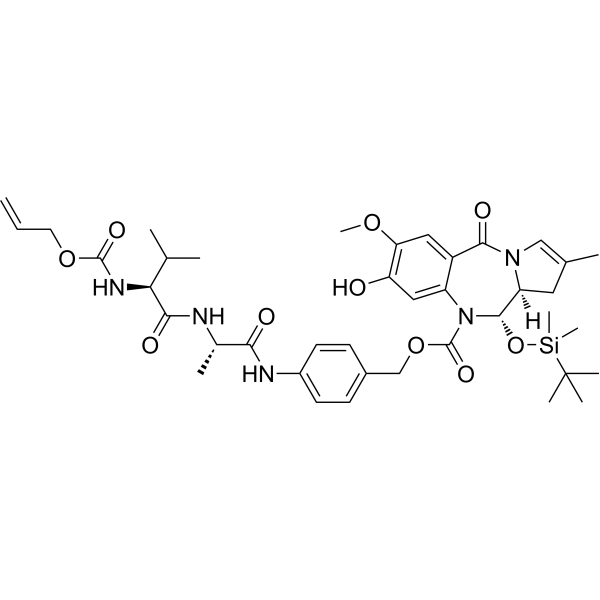
- HY-47820
-
|
|
DNA Alkylator/Crosslinker
|
Cancer
|
|
Tesirine intermediate-1 is the intermediate of Tesirine (HY-128952). Tesirine (SG3249), a pyrrole benzodiazepine (PBD) dimer, is a DNA small channel crosslinker with strong cytotoxicity. Tesirine can be used to synthesize Antibody-Drug Conjugates (ADCs), the warhead component of the payload is SG3199 (HY-101161), which has strong anticancer cell activity.
|
-
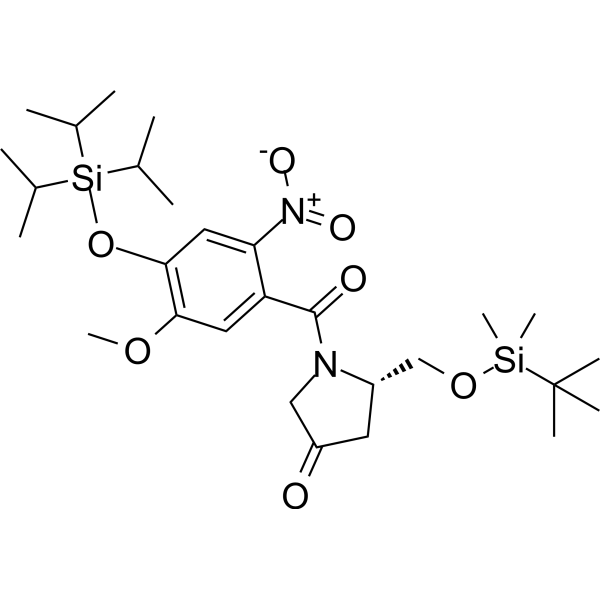
- HY-150233
-
|
|
Microtubule/Tubulin
|
Cancer
|
|
Cys-McMMAF is the released payload of AlMcMMAF, an anti-5T4 humanized A1 antibody conjugated to the microtubule disrupting MMAF (HY-15579) via a maleimidocaproyl linker. Cys-McMMAF has antitumor efficacy in two tumor mouse models (H1975 and MDA-MB-361-DYT2 models) .
|
-
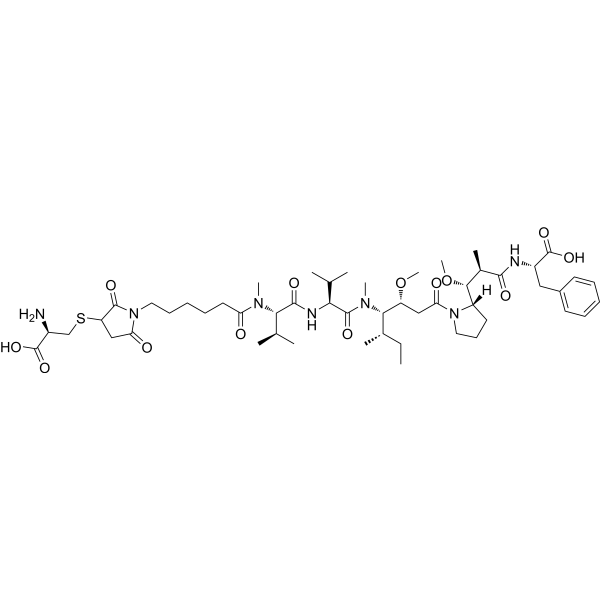
- HY-400687
-
|
|
Others
|
Cancer
|
|
TAM558 intermediate-1 is an intermediate in the synthesis of TAM558 (HY-148127).TAM558 is the payload molecule used in the synthesis of OMTX705.OMTX705 is a humanized anti-fibroblast activation protein (FAP) antibody that binds to the cytolysin TAM470 (HY-148128) and has anti-tumor activity .
|
-
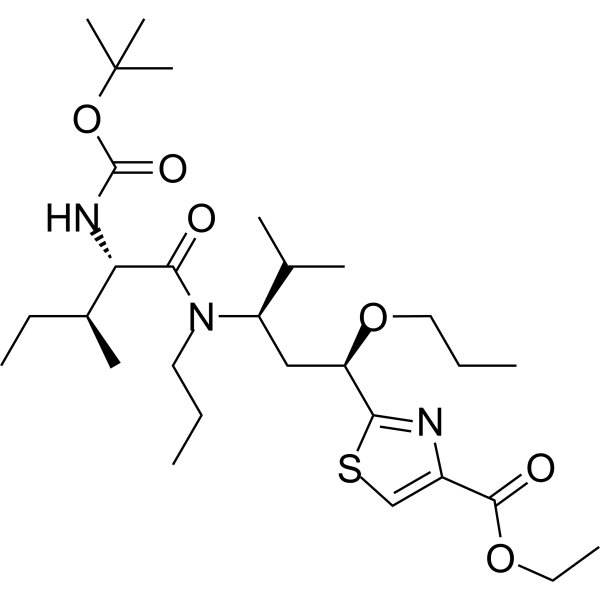
- HY-400688
-
|
|
Others
|
Cancer
|
|
TAM558 intermediate-24 is an intermediate in the synthesis of TAM558 (HY-148127).TAM558 is the payload molecule used in the synthesis of OMTX705.OMTX705 is a humanized anti-fibroblast activation protein (FAP) antibody that binds to the cytolysin TAM470 (HY-148128) and has anti-tumor activity .
|
-
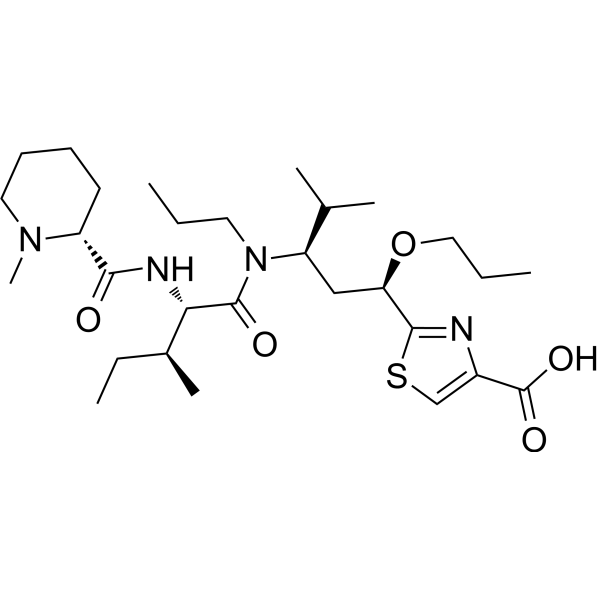
- HY-400689
-
|
|
Others
|
Cancer
|
|
TAM558 intermediate-34 is an intermediate in the synthesis of TAM558 (HY-148127).TAM558 is the payload molecule used in the synthesis of OMTX705.OMTX705 is a humanized anti-fibroblast activation protein (FAP) antibody that binds to the cytolysin TAM470 (HY-148128) and has anti-tumor activity .
|
-

- HY-400690
-
|
|
Others
|
Cancer
|
|
TAM558 intermediate-4 is an intermediate in the synthesis of TAM558 (HY-148127).TAM558 is the payload molecule used in the synthesis of OMTX705.OMTX705 is a humanized anti-fibroblast activation protein (FAP) antibody that binds to the cytolysin TAM470 (HY-148128) and has anti-tumor activity .
|
-
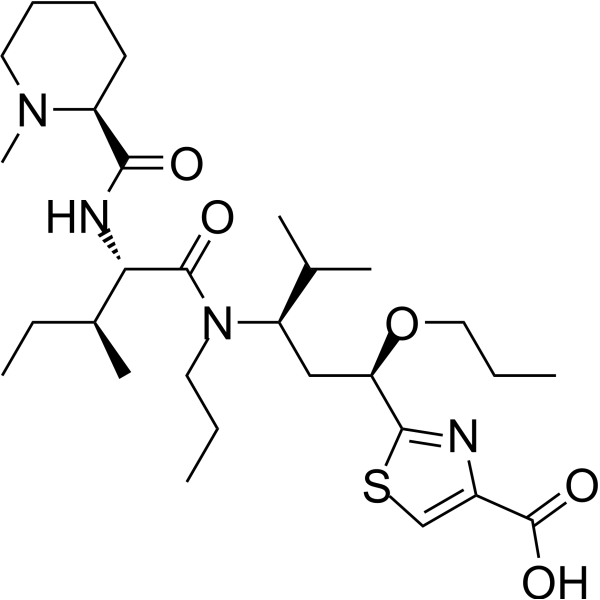
- HY-48564
-
|
|
ADC Cytotoxin
|
Cancer
|
|
TAM558 intermediate-54 is an intermediate in the synthesis of TAM558 (HY-148127).TAM558 is the payload molecule used in the synthesis of OMTX705.OMTX705 is a humanized anti-fibroblast activation protein (FAP) antibody that binds to the cytolysin TAM470 (HY-148128) and has anti-tumor activity .
|
-
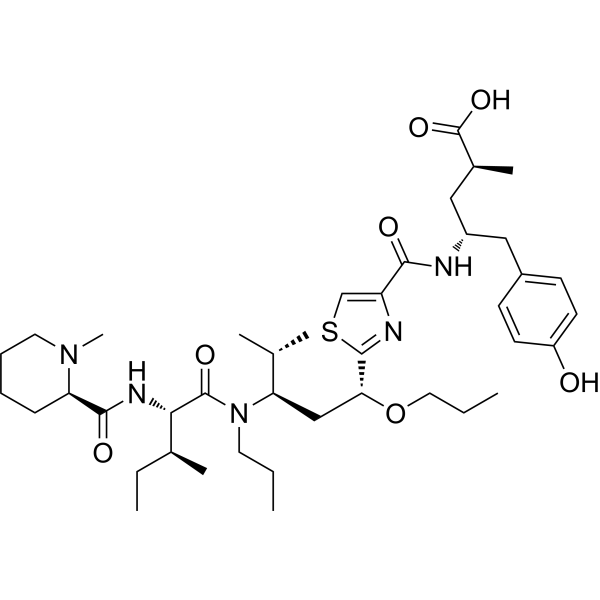
- HY-101982A
-
|
(Rac)-Lys-Nε-MCC-DM1
|
Drug-Linker Conjugates for ADC
|
Cancer
|
|
(Rac)-Lys-SMCC-DM1 ((Rac)-Lys-Nε-MCC-DM1) is the racemate of Lys-SMCC-DM1 (HY-101982). Lys-SMCC-DM1 is a linker-payload component that has the potential to inhibit tubulin polymerization. Lys-SMCC-DM1 is the active metabolite of T-DM1 .
|
-
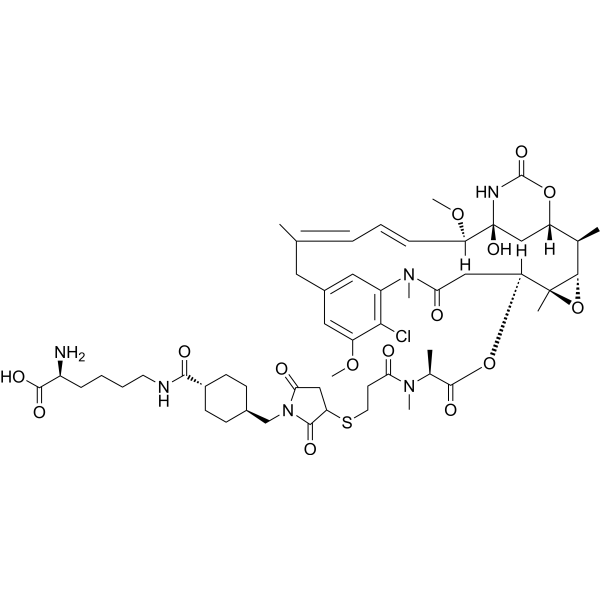
- HY-112616
-
|
|
NAMPT
Drug-Linker Conjugates for ADC
|
Cancer
|
|
NAMPT inhibitor-linker 2 is a agent-linker conjugates for ADC, composed of an NAMPT inhibitor as a payload, and a linker. ADC-4 consists of an NAMPT inhibitor-linker 2 and an anti-c-Kit monoclonal antibody, exihibits potent activity against c-Kit expressing cell lines such as GIST-T1 and NCI-H526, with IC50s of <7 pM and 40 pM, respectively.
|
-

- HY-129589
-
|
|
ADC Cytotoxin
|
Cancer
|
|
Thailanstatin A is an ultra-potent inhibitor of eukaryotic RNA splicing (IC50=650 nM). Thailanstatin A exerts effects via non-covalent binding to the SF3b subunit of the U2 snRNA subcomplex of the spliceosome and shows low-nM to sub-nM IC50s against multiple cancer cell lines. Thailanstatin A, a payload for ADCs, is conjugated to the lysines on trastuzumab yielding “linker-less” ADC .
|
-

- HY-148424
-
|
|
ADC Cytotoxin
|
Cancer
|
|
PBD dimer-2 (compound 2c) is a C8-linked pyrrolobenzodiazepine dimer. PBD dimer-2 can span an extra base pair and cross-link the 5′-Pu-GA(T/A)TC-Py sequence. PBD dimer-2 can be used as a payload for antibody–agent conjugates (ADCs), and it can be used for the research of cancer .
|
-
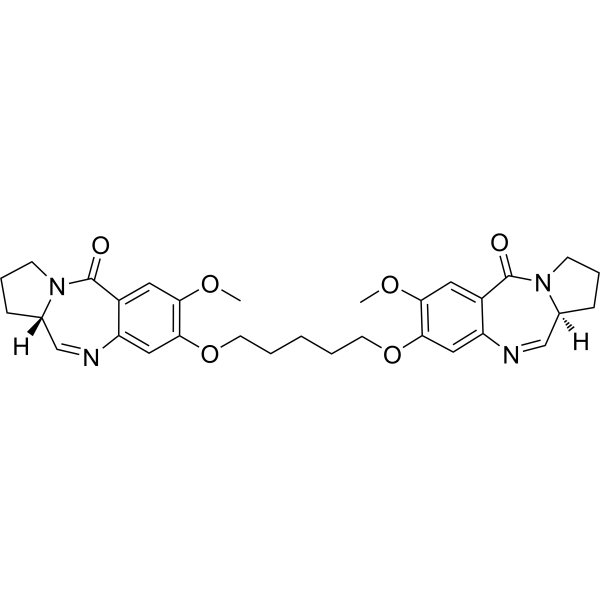
- HY-112615
-
|
|
Drug-Linker Conjugates for ADC
|
Cancer
|
|
NAMPT inhibitor-linker 1 is a agent-linker conjugates for ADC, composed of an NAMPT inhibitor as a payload, and a linker. ADC-3 consists of an NAMPT inhibitor-linker 1 and an anti-c-Kit monoclonal antibody, exihibits potent activity against c-Kit expressing cell lines such as GIST-T1 and NCI-H526 cells, with IC50s of <3 pM and 9 pM, respectively.
|
-

- HY-130161
-
|
|
ADC Linker
PROTAC Linkers
|
Cancer
|
|
m-PEG4-Br is a cleavable ADC linker used in the synthesis of antibody-drug conjugate (ADC) for Trastuzumab (HY-P9907). m-PEG4-Br is placed distally from the monomethyl auristatin E (MMAE) payload to yield an ADC with altered hydrophilicity, antigen binding, and in vitro potency . m-PEG4-Br also can be used as a PROTAC linker that can be used in the synthesis of PROTACs.
|
-
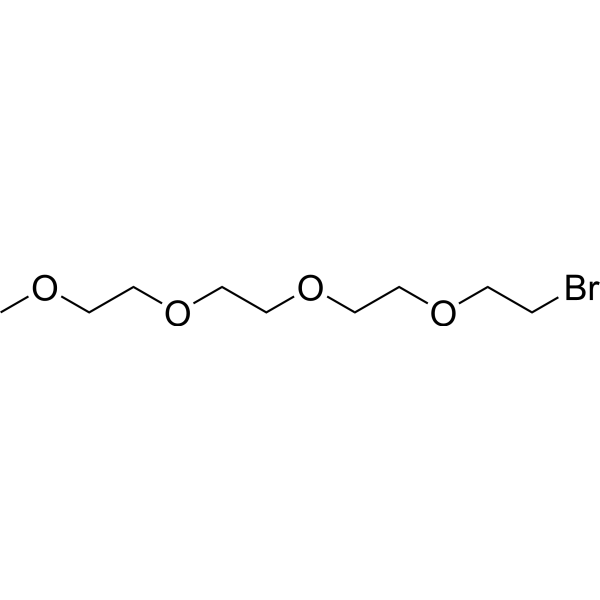
- HY-126690
-
|
|
Drug-Linker Conjugates for ADC
|
Cancer
|
|
DBCO-(PEG2-VC-PAB-MMAE)2 is made by MMAE conjugated to the cleavable DBCO-(PEG2-VC-PAB)2 linker. Monomethyl auristatin E (MMAE), a potent tubulin inhibitor, is a toxin payload in antibody agent conjugate . DBCO-(PEG2-VC-PAB-MMAE)2 is a click chemistry reagent, it contains a DBCO group that can undergo strain-promoted alkyne-azide cycloaddition (SPAAC) with molecules containing Azide groups.
|
-
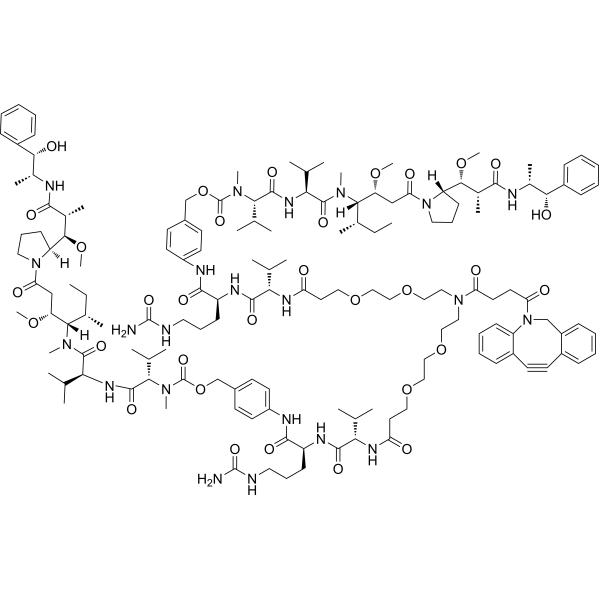
- HY-P99829
-
|
PF-06647020; ABBV-647; h6M24-vc0101
|
Antibody-Drug Conjugates (ADCs)
Microtubule/Tubulin
|
Cancer
|
|
Cofetuzumab pelidotin (PF-06647020) is a PTK7-targeting ADC comprising a humanized anti-PTK7 mAb (hu6M024, IgG1) joined to an auristatin microtubule inhibitor payload, auristatin-0101 (Aur0101; HY-12522), by a cleavable valine-citrulline (vc)-based linker. Cofetuzumab pelidotin has a DAR of 4. Cofetuzumab pelidotin binds to cell-surface PTK7 with an EC50 of 1153 pM by flow cytometry. Cofetuzumab pelidotin has the potential for solid tumors research .
|
-

- HY-153360
-
|
|
Drug-Linker Conjugates for ADC
Topoisomerase
|
Cancer
|
|
MC-GGFG-AM-(10Me-11F-Camptothecin) is a linker-payload conjugate used to synthesize ZW251. ZW251 an antibody-drug conjugate (ADC) targeting human GPC3. ZW251 consists of a humanized IgG1 antibody conjugated to a novel camptothecin-based topoisomerase 1 inhibitor, ZD06519, via a linker. The linker is the maleimide anchor and a glycyl glycyl phenylalanyl glycine (GGFG)-aminomethyl (AM) cleavable linker. ZW251 has high affinity with human and cynomolgus monkey GPC3. ZW251 displays rapid internalization in GPC3-expressing HCC cell lines, and bystander-mediated killing of GPC3 negative cancer cells .
|
-

-
-
HY-L023
-
|
|
94 compounds
|
|
Antibody-Drug Conjugates (ADCs), a new class of treatment for cancer, are composed with a monoclonal antibody, a linker and a cytotoxic agent also referred to as a payload. To date, several ADCs have received market approval and more than 60 ADCs are currently in clinical trials. ADCs are one of the fastest growing classes of oncology drugs worldwide.
The payload or cytotoxic agent is the most important unit in the ADC. ADC has the capability to kill cancer cell depending on the potency of the payload. MCE provides 94 highly potent cytotoxins that contain auristatin derivatives, maytansinoids, calicheamicin, duocarmycin, pyrrolobenzodiazepines (PBDs), etc.
|
| Cat. No. |
Product Name |
Target |
Research Area |
-
- HY-P2073
-
|
|
Liposome
|
Cancer
|
|
Cyclo(δ-Ala-L-Val) is a liposome to simulate biological phospholipid membrane. Liposomes are the main component of vesicles with concentric phospholipid bilayer membranes, which can be used to construct drug delivery systems for anti-cancer and anti-infection fields. Highly polar water-soluble payloads can be trapped in the internal aqueous space of liposomes, while lipophilic payloads can partition into and become part of the lipid bilayer. Especially for delivering antisense oligonucleotides, it can overcome problems such as inefficient cellular uptake and rapid loss in the body .
|
-
- HY-P10442
-
|
|
Liposome
|
Cancer
|
|
Cinnamosyn is a liposome to simulate biological phospholipid membrane. Liposomes are the main component of vesicles with concentric phospholipid bilayer membranes, which can be used to construct drug delivery systems for anti-cancer and anti-infection fields. Highly polar water-soluble payloads can be trapped in the internal aqueous space of liposomes, while lipophilic payloads can partition into and become part of the lipid bilayer. Especially for delivering antisense oligonucleotides, it can overcome problems such as inefficient cellular uptake and rapid loss in the body .
|
| Cat. No. |
Product Name |
Target |
Research Area |
-
- HY-P99813
-
|
HER3-DXd
|
Antibody-Drug Conjugates (ADCs)
|
Cancer
|
|
Patritumab deruxtecan (HER3-DXd) is an antibody-drug conjugate (ADC) consisting of a fully human anti-HER3 IgG1 monoclonal antibody Patritumab (HY-P99275) attached to a topoisomerase I inhibitor payload via a tetrapeptide-based cleavable linker. Patritumab deruxtecan shows anticancer activity .
|
-
- HY-P99829
-
|
PF-06647020; ABBV-647; h6M24-vc0101
|
Antibody-Drug Conjugates (ADCs)
Microtubule/Tubulin
|
Cancer
|
|
Cofetuzumab pelidotin (PF-06647020) is a PTK7-targeting ADC comprising a humanized anti-PTK7 mAb (hu6M024, IgG1) joined to an auristatin microtubule inhibitor payload, auristatin-0101 (Aur0101; HY-12522), by a cleavable valine-citrulline (vc)-based linker. Cofetuzumab pelidotin has a DAR of 4. Cofetuzumab pelidotin binds to cell-surface PTK7 with an EC50 of 1153 pM by flow cytometry. Cofetuzumab pelidotin has the potential for solid tumors research .
|
| Cat. No. |
Product Name |
Category |
Target |
Chemical Structure |
| Cat. No. |
Product Name |
Chemical Structure |
-
- HY-156756S
-
|
|
|
7-Hydroxymethyl-10,11-MDCPT-d5 is deuterium labeled 7-Hydroxymethyl-10,11-MDCPT, which is a is a payload that can be used for ADC synthesis .
|
-

| Cat. No. |
Product Name |
|
Classification |
-
- HY-163099
-
|
|
|
Alkynes
|
|
P5(PEG24)-VC-PAB-exatecan is a camptothecin-based linker-payload platform based on the highly potent camptothecin derivative exatecan. P5(PEG24)-VC-PAB-exatecan has linker-payload structures. P5(PEG24)-VC-PAB-exatecan can be used for the research of tumor .
|
-
- HY-147363
-
|
|
|
ADC Synthesis
DBCO
|
|
DIBAC-GGFG-NH2CH2-Dxd (compound LP4), a Camptothecin (HY-16560) derivative, is a linker-payload of protein-agent conjugates . Dxd (HY-13631D) can be used as a payload for the antibody-coupling drug ADC (DS-8201a).DIBAC-GGFG-NH2CH2-Dxd is a click chemistry reagent, it contains a DBCO group that can undergo strain-promoted alkyne-azide cycloaddition (SPAAC) with molecules containing Azide groups.
|
-
- HY-126690
-
|
|
|
DBCO
|
|
DBCO-(PEG2-VC-PAB-MMAE)2 is made by MMAE conjugated to the cleavable DBCO-(PEG2-VC-PAB)2 linker. Monomethyl auristatin E (MMAE), a potent tubulin inhibitor, is a toxin payload in antibody agent conjugate . DBCO-(PEG2-VC-PAB-MMAE)2 is a click chemistry reagent, it contains a DBCO group that can undergo strain-promoted alkyne-azide cycloaddition (SPAAC) with molecules containing Azide groups.
|
-
- HY-W440694
-
|
|
|
Azide
|
|
Cholesterol-PEG-Azide (MW 2000) is a liposome to simulate biological phospholipid membrane. Liposomes are the main component of vesicles with concentric phospholipid bilayer membranes, which can be used to construct drug delivery systems for anti-cancer and anti-infection fields. Highly polar water-soluble payloads can be trapped in the internal aqueous space of liposomes, while lipophilic payloads can partition into and become part of the lipid bilayer. Especially for delivering antisense oligonucleotides, it can overcome problems such as inefficient cellular uptake and rapid loss in the body .
|
Your information is safe with us. * Required Fields.
Inquiry Information
- Product Name:
- Cat. No.:
- Quantity:
- MCE Japan Authorized Agent:








![Exatecan-amide-bicyclo[1.1.1]pentan-1-ol](http://file.medchemexpress.com/product_pic/hy-160597.gif)


























































![23:2 Diyne PE [DC(8,9)PE]](http://file.medchemexpress.com/product_pic/hy-w800784.gif)


































